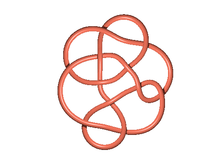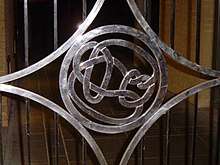Conway knot
In mathematics, in particular knot theory, the Conway knot (or Conway's knot) is a particular knot with 11 crossings, named after John Horton Conway.[1] It is related by mutation to the Kinoshita–Terasaka knot,[2] with which it shares the same Jones polynomial.[3][4] Both knots also have the curious property of having the same Alexander polynomial and Conway polynomial as the unknot.[5]
| Conway knot | |
|---|---|
 | |
| Crossing no. | 11 |
| Genus | 3 |
| Thistlethwaite | 11n34 |
| Other | |
| , prime | |

Conway knot emblem on a closed gate of mathematics department of University of Cambridge.
The issue of the sliceness of the Conway knot was resolved in 2020 by Lisa Piccirillo, 50 years after John Horton Conway first proposed the knot.[6][5] Her proof made use of Rasmussen's s-invariant, and showed that the knot is not a slice knot.[7]
References
- Weisstein, Eric W. "Conway's Knot". mathworld.wolfram.com. Retrieved 2020-05-19.
- "Mutant Knots" (PDF). 2007.
- "KNOTS". homepages.math.uic.edu. Retrieved 2020-06-09.
- Litjens, Bart (August 16, 2011). "Knot theory and the Alexander polynomial" (PDF). esc.fnwi.uva.nl. p. 12. Retrieved 9 June 2020.
- Piccirillo, Lisa (2020). "The Conway knot is not slice". Annals of Mathematics. 191 (2): 581–591. doi:10.4007/annals.2020.191.2.5. JSTOR 10.4007/annals.2020.191.2.5.
- Klarreich, Erica. "Graduate Student Solves Decades-Old Conway Knot Problem". Quanta Magazine. Retrieved 2020-05-19.
- Klarreich, Erica. "In a Single Measure, Invariants Capture the Essence of Math Objects". Quanta Magazine. Retrieved 2020-06-08.
External links
- Conway knot on The Knot Atlas.
- Conway knot illustrated by knotilus.
This article is issued from Wikipedia. The text is licensed under Creative Commons - Attribution - Sharealike. Additional terms may apply for the media files.